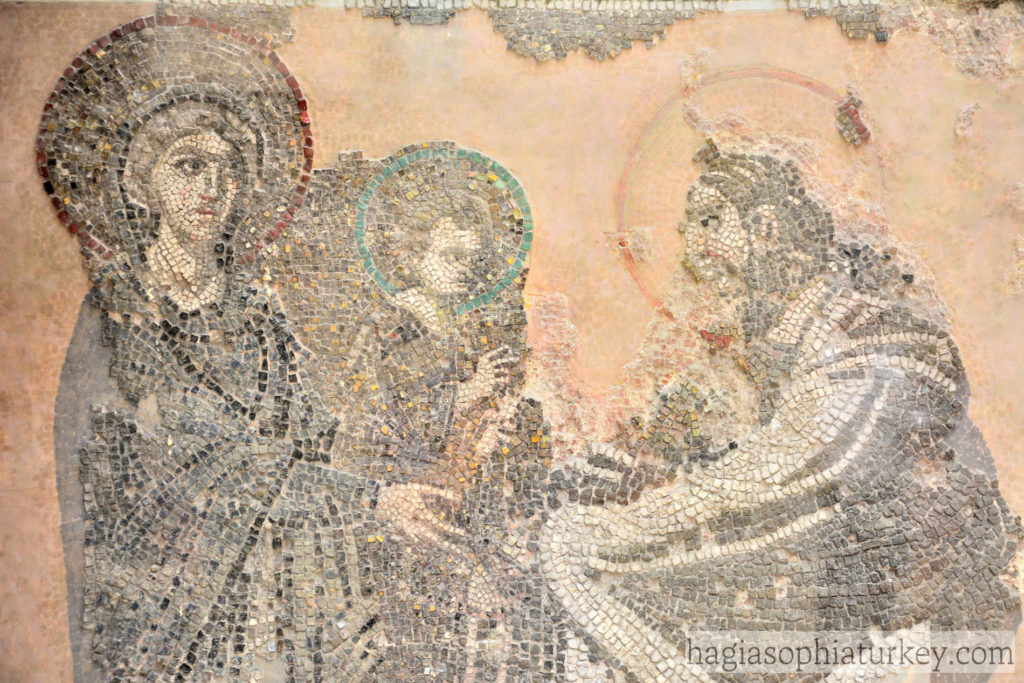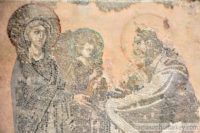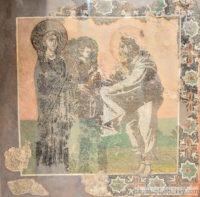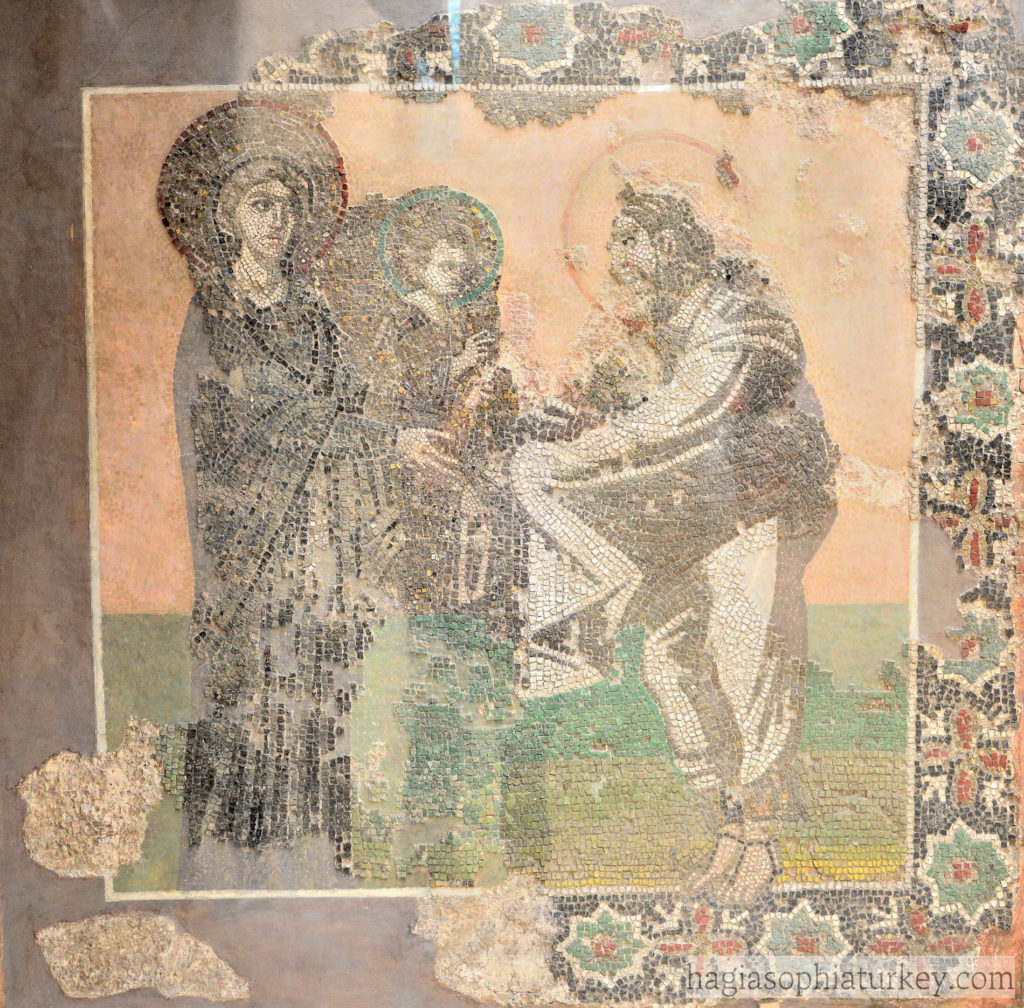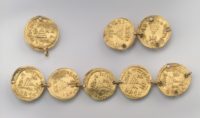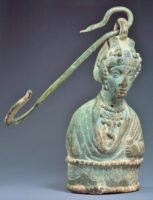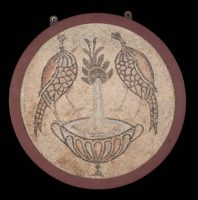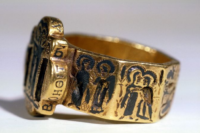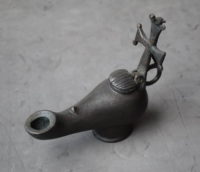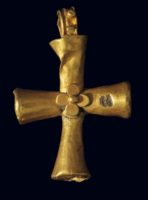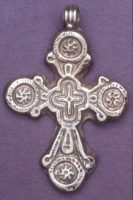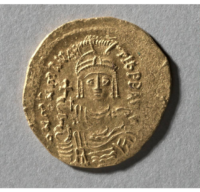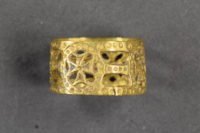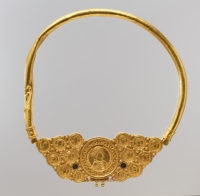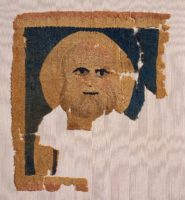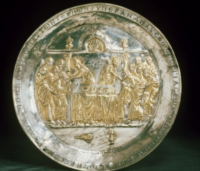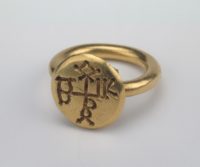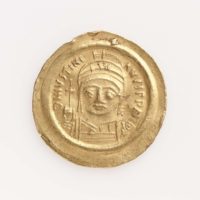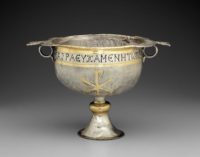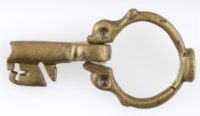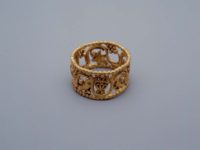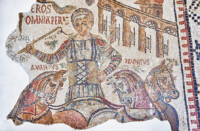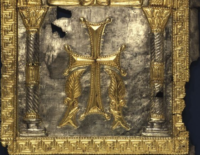Mosaic Panel. Period: Early Byzantine; circa: Late 6th – early 7th century. Findspot: Istanbul, Kalenderhane Mosque excavations. Decorated the southern niche of the apse; it depicts the earliest presentation scene, the hypapante, found in Istanbul. Materials: stone, glass. In the Istanbul Archaeological Museum collections, there are rich and very important works of art belonging to various civilizations from the regions from Africa to Balkans , from Anatolia and Mesopotamia to Arab Peninsula and Afghanistan that were in the borders of the Ottoman Empire.
Fragment of a Necklace Consisting of Eight Coins, Period: Early Byzantine. circa: Between 637 and 646. Found: Pereshchepina Complex. near Poltava, the Village of Malaya Pereshchepina. Material: gold. The collection of the State Hermitage includes over 3 million works of art and world culture artefacts. It contains paintings, graphic works, sculptures, works of applied art, archaeological artefacts and numismatic objects. The Hermitage is considered to have been founded in 1764, when Empress Catherine the Great acquired an impressive collection of works from the Berlin merchant Johann Ernst Gotzkowsky. The museum celebrates the anniversary of its founding each year on 7 December, St. Catherine’s Day. Opening Hours: Tuesday, Thursday, Saturday, Sunday: 10.30-18.00 Wednesday, Friday: 10.30-21.00 Closed: Monday.
Steelyard Weight with a Bust of a Byzantine Empress and a Hook. This Byzantine steelyard weight dates from the first half of the 5th century. The bronze hook would permit it to be suspended from and moved along a ruled steelyard to determine the weight of an item hung from the opposite end. The Metropolitan Museum of Art (New York) is one of the world’s largest and finest art museums. Its collection includes more than two million works of art spanning five thousand years of world culture, from prehistory to the present and from every part of the globe. Public Hours: 10:30 a.m.–5:30 p.m. Open seven days a week.
Mosaic, Two Peacocks Perch on a Fountain, Period: Early Byzantine, circa: A.D. 450–462. The MFA is open 7 days a week. Monday and Tuesday 10 am–5 pm, Wednesday–Friday 10 am–10 pm, Saturday and Sunday 10 am–5 pm.
Sapphire and Tourmaline Ring Gems; Period: Early Byzantine, circa: 6-7th century. Findspot/Location: Constantinople. Materials: Sapphire, Tourmaline. In the Istanbul Archaeological Museum collections, there are rich and very important works of art belonging to various civilizations from the regions from Africa to Balkans , from Anatolia and Mesopotamia to Arab Peninsula and Afghanistan that were in the borders of the Ottoman Empire.
Octagonal Marriage Ring with Holy Site Scenes, Period: Early Byzantine, circa: 7th Century. Materials: gold with niello.The museum is open to the public Tuesday through Sunday, 11:30 a.m.–5:30 p.m., except for federal holidays.
Lamp, Made in: Luxor, Egypt. Period: Early Byzantine circa: 6th-7th century. Subjects: Cross, bird. Found/Acquired: Luxor. Materials: Bronze. British Museum is closed 24, 25 and 26 December and 1 January, but is open every other day of the year. Fast facts about the British Museum: Founded: 1753, Collection size: 8 million objects, Oldest object in the collection: Stone chopping tool (nearly 2 million years old).
Cross, with a decorative quatrefoil rosette at the juncture of the arms. Materials: gold. Period: Early Byzantine; circa: Early 7th c. The Benaki Museum of Greek Culture is housed in one of the most beautiful neoclassical-style buildings in Athens, near the National Garden and the Hellenic Parliament.
[xyz-ihs snippet="Benaki-Hotels"]Pendant Cross, Period: Early Byzantine (7thc.) Height: 55.8 millimetres Width: 37.2 millimetres Depth: 7 millimetres Weight: 7.27 grammes. Materials: Gold. British Museum is closed 24, 25 and 26 December and 1 January, but is open every other day of the year. Fast facts about the British Museum: Founded: 1753, Collection size: 8 million objects, Oldest object in the collection: Stone chopping tool (nearly 2 million years old).
Solidus of Maurice Tiberius, 583-602, Material: gold, Diameter: w. 2.2 cm (13/16 in.). The Cleveland Art Museum Hours: Tuesdays, Thursdays, Saturdays, Sundays 10:00 a.m.–5:00 p.m. Wednesdays, Fridays 10:00 a.m.–9:00 p.m. Closed Mondays.
Gold Finger Ring; Early Byzantine. Period: 7thC – Early Byzantine. Excavated/Findspot: Smyrna (Asia, Turkey, Aegean Region, Anatolia (Turkey). British Museum is closed 24, 25 and 26 December and 1 January, but is open every other day of the year. Fast facts about the British Museum: Founded: 1753, Collection size: 8 million objects, Oldest object in the collection: Stone chopping tool (nearly 2 million years old).
Pectoral with Coins and Pseudo-Medallion, Period: Early Byzantine, circa: 539–50, Materials: Gold, niello, On view at The Met Fifth Avenue in Gallery 302. The Metropolitan Museum of Art (New York) is one of the world’s largest and finest art museums. Its collection includes more than two million works of art spanning five thousand years of world culture, from prehistory to the present and from every part of the globe. Public Hours: 10:30 a.m.–5:30 p.m. Open seven days a week.
Tapestry panel: Head of a man. Coptic, Egypt. Period: Early Byzantine circa: 4th-5th century A.D. Dimensions: 23.5 x 20 cm (9 1/4 x 7 7/8 in.); Legacy dimension: 23.5 x 20.0 cm. Materials: Wool. The MFA is open 7 days a week. Monday and Tuesday 10 am–5 pm, Wednesday–Friday 10 am–10 pm, Saturday and Sunday 10 am–5 pm.
Paten with the Communion of the Apostles, Period: Early Byzantine (565-578 A.D.) Materials: silver, gilding and niello. The museum is open to the public Tuesday through Sunday, 11:30 a.m.–5:30 p.m., except for federal holidays.
Ring Decorated with a Monogram, Period: Early Byzantine, circa: 7th century. Found: Pereshchepina Complex. near Poltava, the Village of Malaya Pereshchepina. Materials: gold. Technique: cast, polished, soldered and engraved. The collection of the State Hermitage includes over 3 million works of art and world culture artefacts. It contains paintings, graphic works, sculptures, works of applied art, archaeological artefacts and numismatic objects. The Hermitage is considered to have been founded in 1764, when Empress Catherine the Great acquired an impressive collection of works from the Berlin merchant Johann Ernst Gotzkowsky. The museum celebrates the anniversary of its founding each year on 7 December, St. Catherine’s Day. Opening Hours: Tuesday, Thursday, Saturday, Sunday: 10.30-18.00 Wednesday, Friday: 10.30-21.00 Closed: Monday.
Solidus of Justinian I, Period: Early Byzantine, circa: 552–565 A.D. Minted in: Ravenna, Material: Gold. The Museum of Fine Arts, Boston is open 7 days a week. Monday and Tuesday 10 am–5 pm, Wednesday–Friday 10 am–10 pm, Saturday and Sunday 10 am–5 pm.
Silver Chalice, Period: Early Byzantine, circa: 6th century A.D. Dimensions: Height (max.): 18 cm. (7 1/16 in.); Width (max. at handles): 26.6 cm (10 1/2 in.); Width (bowl): 16 cm (6 5/16 in.).
The cup has actually ring handles topped by flat plates of lunate kind with trapezoidal forecasts in the line of the handles. An inscribed band in between the manages is flanked by a gilded profiled rim (above) and a gilded profiled band listed below. The body is hemispherical. The high foot includes a concave, then round stem and a cone-shaped assistance with broad, horizontal flange listed below. The niello-inlaid engraving (in Greek uppercase) equates: “Sarah hoped and made [this] using to the First Martyr” (Saint Stephen). Likewise (each side) is a gilded Christogram made up of a chi and rho (the very first 2 letters of Christ’s name in Greek) flanked by alpha and Omega. These are the first and last letters of the Greek alphabet, symbolizing that Christ is the beginning and end of all things. Locations of the bowl are completed; foot is corrected and repaired.
The MFA is open 7 days a week. Monday and Tuesday 10 am–5 pm, Wednesday–Friday 10 am–10 pm, Saturday and Sunday 10 am–5 pm.
Key, Materials: Bronze. Made in: Constantinople. Period: Early Byzantine (?). The Benaki Museum of Greek Culture is housed in one of the most beautiful neoclassical-style buildings in Athens, near the National Garden and the Hellenic Parliament.
Ring in Openwork Filigree, Period: Early Byzantine Period, circa: A.D. 550–650. Material: Gold. The MFA is open 7 days a week. Monday and Tuesday 10 am–5 pm, Wednesday–Friday 10 am–10 pm, Saturday and Sunday 10 am–5 pm.
4th century Roman mosaic panel of Eros, a circus chariot rider of the Red Fraction. From Tunisia. The Bardo Museum, Tunis, Tunisia.
Book Cover with a Cross Flanked by Cypress Trees, Period: Early Byzantine, circa: Mid 6th Century. The museum is open to the public Tuesday through Sunday, 11:30 a.m.–5:30 p.m., except for federal holidays.


